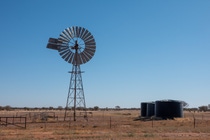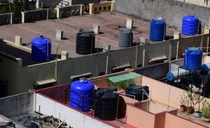Sustainability
BASF plastic additives protect scarce water in drought-hit regions by improving the durability of plastic water tanks
Countries across Asia Pacific have something in common: untenable water use and management practices. With temperatures rising, devastating droughts are becoming a norm. Water scarcities have reached high-anxiety threat levels in many countries. Droughts are a recurring and challenging experience, taking their toll on a country’s economy and leading to loss of human and economic capital. To mitigate the impact, governments across the region have introduced various water management plans – one being the installation of plastic water tanks.
Plastic water tanks survive and enable survival in the Australian outback

The Australian outback is one of the hottest and driest places on earth. In rural and remote towns, fresh water is a limited and valuable commodity.
Living and surviving under such severe climatic conditions depends on the use of water collected in plastic water tanks. But, wouldn’t the harsh Australian sun be too much for water tanks made of polyethylene (PE) to handle?
“Not if they are UV stabilized,” said Hermann Althoff, BASF’s Senior Vice President, Performance Chemicals Asia Pacific. “It is common knowledge that PE degrades when exposed to UV radiation from the sun. Over time, the surface chalks and cracks, and the polymer becomes brittle, as its structural integrity is compromised. For this application, we recommend Irgastab® IS 2580 and Irgastab® IS 2515, our fully formulated solutions for roto-molding PE grades. It helps to maintain the integrity of polymer properties during processing and provides long-term durability to the water tanks by preventing degradation from UV rays, thermal stress and oxidation.”
BASF’s plastic additives have been adopted by many customers in Australia to make rotationally-molded linear low-density polyethylene (LLDPE) water storage tanks.
In the case of plastic water tanks, excellent physical performance is of little value, unless the product is tough enough to maintain its long-term performance under the sun.
Parts of Australia have a very high UV Index (an international standard measurement of the strength of UV radiation). Peak daily values in summer are regularly over 12-14 and can even reach 16-17 at more northern latitudes.
As a reference, the World Health Organization warns against spending time outside when the UV index tops 10, which is considered extreme, where exposure to direct sunlight for 15 minutes can cause sunburn.
Now, imagine a plastic water tank positioned outside every day under such extreme UV levels. Over time, UV exposure to inadequately stabilized water tanks can result in the weathering of polyethylene tanks.
Traditionally a UV8 level of stabilization has been considered the minimum required for long-term protection. However, to withstand the demands of daily use in Australia, UV20 is the required “longer-term” protection.
Preserving rooftop plastic water tanks in India

Australia is not alone. Drought conditions are widespread throughout ASEAN. While in India, droughts have been reported at least once every three years, during the past five decades.
The advanced stabilization solutions from the Irgastab® range have been adopted by Volga Polymers, a major converter and manufacturer of PE water tanks in India. These are usually installed on the rooftops of buildings. Volga Polymers has installed most of these tanks in the southern Indian state of Tamil Nadu, where the UV index often peaks at 12.
“We tried solutions from other suppliers, but the tanks barely lasted a year. We got the best results with BASF’s technology, and now we can provide our customers with more durable products that also retain food contact and drinking water approvals,” said Mr. Bhoopathy, General Manager of Volga Polymers.
BASF plastic additives provide customers additional sustainability benefits
“It’s clear that using the right additives can improve the lifetime of PE tanks in extreme weather conditions. By extending the durability, customers can also reduce plastic waste and ultimately costs by replacing their tanks less frequently. Ensuring that water isn’t lost due to tank failure and leakage in severe drought conditions helps reduce the growing concern for human and environmental health,” said Dr. Marina Leed, Global Sustainability Manager for Plastic Additives.
In addition to improving technical performance of the tanks, Irgastab® products also have other significant contributions to a sustainable future. During the roto-molding process, Irgastab® reduces energy consumption by enabling shorter processing times and lower molding temperatures. This further increases the service life of the molded product.